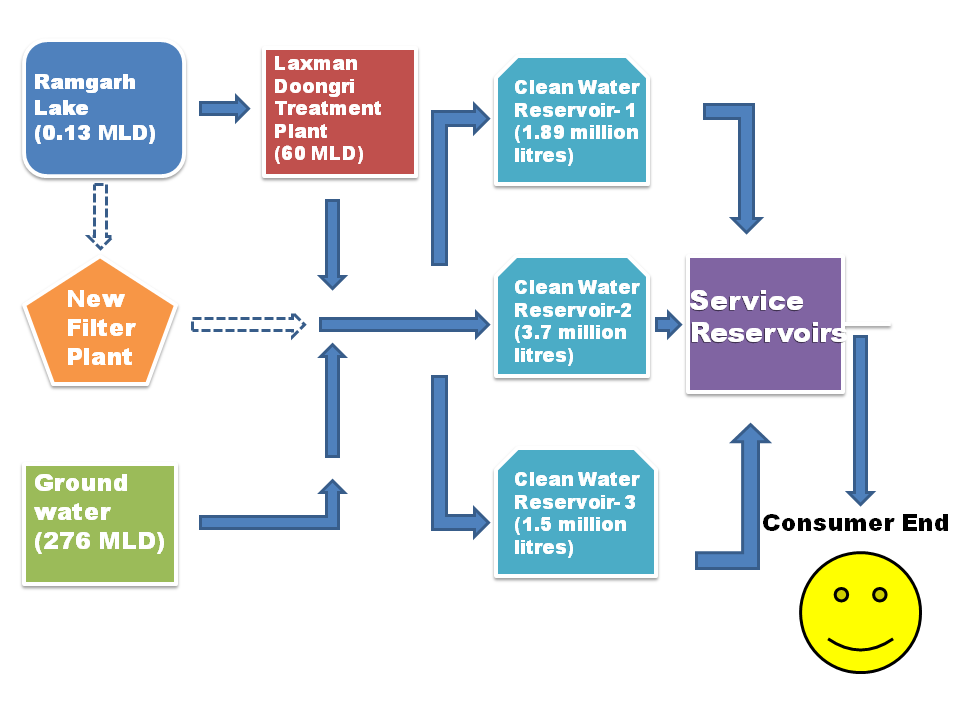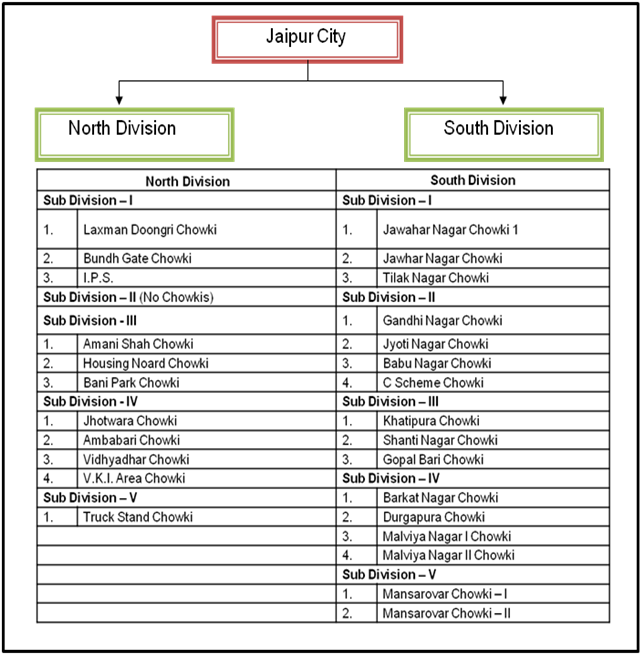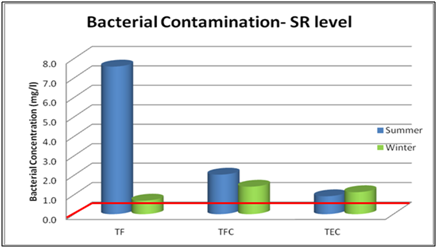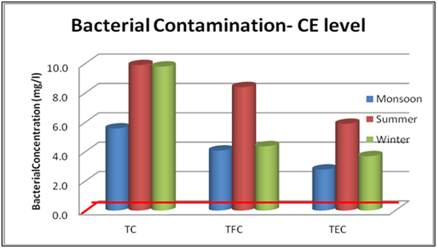Jaipur, the capital of Rajasthan, receives a little over 276 million litres of water every day. This is predominantly groundwater, with water from the Ramgarh lake forming a small percent. Using data obtained from the Public Health Engineering Department of Rajasthan and from NEERI, this article traces the route of water from its source to the consumer. The treatment measures taken and the quality of water at various points of treatment are explained. The article ends with a list of suggestions for improvement.
Background
Jaipur, the capital of Rajasthan is one of India's modern cities with 3.1 million (Census 2011) residents. Jaipur is largely dependent on groundwater for its drinking water supply: 90% of the total drinking water demand of the city is dependent on groundwater, while 10% is supplied from the Ramgarh Lake situated 35 km from the city. The water supply in the city is maintained by Public Health Engineering Department (PHED) Rajasthan.
The depth of the ground water table varies from 15 to 40 m with seasonal variations of 1 to 3m. There are 990 tube wells over the city through which 276 million litres per day (mld) of raw water is fetched.
Ramgarh Lake is the only surface water source of the city. It is an impounded reservoir located 35 km northeast of the city. The lake is dependent on rainfall for its water supply. It was constructed in 1903 with a gross storage capacity of 2650 million cubic feet. Due to the semi-arid climate zone, rainfall is sparse. Thus the lake almost dried up. Presently about 0.13 mld (0.35 lakh gallon/day) of water is taken from the lake due to erratic rainfall.
The water supply system in Jaipur
There are two water treatment plants in the city
- Laxman Doongri Treatment Plant - Located in the eastern fringe of Jaipur city on the Jaipur Delhi Bypass, it is city's prime water treatment plant. In the year 1956, the capacity of the plant was augmented to treat 33 MLD of water. Further reorganization of the Jaipur water supply was undertaken in the year 1963 and the total design capacity of the filter plant was increased to treat 60 MLD of water. Presently however, due to the acute shortage of water in Ramgarh Lake the plant is run to treat only 0.13 MLD of water.
- New Filter Plant – It is located near the Band Gate Intermediate Pumping station. However due to paucity of water the plant has been closed down for three years. The plant has been shown by dotted lines in figure-1.

Figure-1: A simplified pictorial representation of the drinking water supply system of Jaipur city.
All the basic water treatment procedures like pre-chlorination, alum, lime dosing, flocculation, settling, filtration and chlorination are carried out in the Laxman Doongri treatment plant. Water from the treatment plant is then stored in clean water reservoirs.
There are three Clean Water Reservoirs (CWRS) where the treated water is stored after disinfection. The three reservoirs have the following storage volumes 1.89, 3.7 and 1.5 ml. The reservoirs are constructed of stone masonry and RCC. According to PHED officials the CWRs are well ventilated but there is no provision for control of mosquito and other aquatic insects. The reservoirs were last cleaned in December 2000.
The water from the reservoirs is then pumped into CWRS of the various zones of the city. Then from the associated CWRs to the Overhead Service Reservoir of associated locality, gravity takes care of the water supply. There are a total of 54 CWRs and 57 service reservoirs (one CWR may supply water to two SRs).The city is divided into two divisions- north and south division. Each Division is then divided into five subdivisions and each subdivision is again further divided into two or three Chowkis forming a total of 27 chowkis.

Fig 2- Administrative divisions for water supply in Jaipur
Water quality checks:
The National Environmental Engineering Research Institute, Nagpur in 2001 had carried out quality checks of the water at all the stages i.e treatment level, clean water reservoir level, service reservoir level and at consumer end level for the three seasons (monsoon, summer and winter).
- Water samples were monitored for all the physico-chemical at treatment level and clean water reservoir level..
- At the service reservoir and consumer end, water samples were tested for residual chlorine and bacteriological parameters.
Water quality analysis:
Below is an analysis of the test report from the treatment level up to the consumer end level.
1) Treatment level
All the physio-chemical parameters as indicated by BIS :10500 norms were tested, but no bacteriological test was done. Out of the physio-chemical parameters the samples had TDS, Alkalinity, Hardness, Calcium and Magnesium, at a much higher concentration than the permissible levels. Samples were collected for six days in each season, but in the following graphs the average values of the parameters have been shown. In all the graphs the red line indicates the permissible concentration of the parameters.
2) Clean water reservoir level
At this stage samples from 25 Clean Water Reservoirs have been taken on various dates for three seasons. Here also the average concentrations have been taken into account for TDS, Alkalinity, Hardness, Calcium and Magnesium.
3). Service reservoir
At the service reservoirs level water samples have been tested for residual chlorine, Total Coliform (TC), Total Faecal Coliforms (TFC) and Total E.coli (TEC) concentration. The sampling has been done for winter and monsoon seasons only.

4). Consumer level
Same as the service reservoir level Total Coliform (TC), Total Faecal Coliforms (TFC) and Total E.Coli (TEC) concentration in the samples were analysed for all the seasons.

Discussion:
At the treatment level-
- TDS levels in all the samples are much higher than the 500mg/l permissible level.
This could be due to the aquifer structure of the area. Aquifer structure pertains to the rock structure below the ground level that allows the flow of the groundwater. The mineral composition of the aquifer affects the quality of the groundwater. Thus the predominant ions of the aquifer are also found in the groundwater in higher concentration. In the Jaipur region the ground water is Ca-Mg Cl SO4 NO3 type. Thus calcium, magnesium, chloride, sulphate and nitrate are the dominant ions found in the ground water. Presence of these ions in higher level leads to high TDS, hardness and alkalinity in the water.
- Water samples have not been tested for Total Coliforms and Total Faecal Coliforms.
It should be done as damage has been reported by PHED officials in the chlorine tower and dosing line in the treatment plant. Also algal growth has been reported in the channels, clarifiers and filter beds.
At CWR level-
- High concentration of calcium and magnesium is detected in all the water samples for all the seasons.
- In some samples TDS, Hardness and alkalinity values are above permissible level.
Inadequate treatment facilities can be attributed to the high concentrations of the above parameters after treatment.
At service reservoir level-
- Bacterial contamination is observed in less than 15 % of the sample out of the total samples. Residual chlorine concentration in these samples has been found to be less than 0.2 mg/l (desirable limit according to BIS standards). No reasons have been attributed by the officials for the above situation.
- Bacterial tests have not been carried out for samples with residual chlorine concentration more than 0.2 mg/l. Testing of samples should be made mandatory to ensure no bacterial contamination in the samples.
At consumer end level -
- Approximately 30% of the total samples in the three seasons are contaminated with bacteria. This increase in the bacterial contaminated water samples from the service reservoir level to consumer end level suggests there could be cross contamination with sewage pipe lines. However according to PHED officials cross connection between drinking water pipelines and sewage lines cannot be an option as leaked sewage lines which were running close to water pipe line have been shifted.
Conclusion
70% of the city is receiving bacterial uncontaminated water at the consumer end. However, the water is still not upto BIS standards due to a high concentration of TDS, hardness, alkalinity, calcium, and magnesium. These are linked as the presence of calcium and magnesium leads to high TDS, alkalinity and hardness. Thus managing these is important to controlling the problem of high TDS, alkalinity and hardness. It should be noted that the intake of water with calcium, magnesium, hardness, TDS and alkalinity levels above the permissible level does not pose any serious threat to most individuals, though certain people are at risk. The risks are as follows:
- Calcium- Though excess calcium is excreted through the kidneys of a healthy person, it may be fatal for people suffering lactose intolerance.
- Hardness- According to reports of World Health Organization, there are no side effects associated with consuming hard water. Some studies however, have shown a weak link of eczema in children with hard water.
Apart from the above health problems for certain people, hard water causes other problems like scaling of pipes. The calcium and magnesium of the water gets deposited on the pipes in carbonate form. This can lead to clogging of the pipes, decreased efficiency of water heating and filtering devices. Also hard water tends to reduce the efficiency of soap.
Action points
The main challenge of PHED is to provide standardised quality drinking water to the consumer. Action should be taken from the plant level to the consumer end level to manage the problems.
- Flash mixer installation
Installation of flash mixer at Laxman Doongri treatment Plant to avoid manual mixing of alum solution thus increasing the efficiency of floc formulation which would improve sedimentations.
- Cleaning of treatment plant
Repairing the clarrifloculator, chlorine dosing pipeline and chlorine tower. Also cleaning the treatment plant as algal growth has been reported by PHED officials in the towers and sedimentation tank.
- Cleaning of CWRS
According to PHED officials the CWRs were last cleaned in 2000. Also tackle the problem of controlling mosquito and aquatic insects.
- Installation of preparation tanks-
In the some areas due to the absence of functional preparation tanks ,disinfection is done by mixing bleaching powder solution in a buckect at Service Resevoir stage. Thus installation of functional preparation tank at each Service Reservoir should be done.
- Checks on existing water supply pipelines-
Checking of water distribution pipeline should be done to guarantee that there is no cross linking of water pipeline with sewage network.
- Water quality checks-
Frequent water quality checks at all the levels ( treatment, service reservoirs, consumer end ) should be done to maintain the water quality.
- Sustainable use of rainwater
Rain water harvesting should be promoted at household level. This initiative will not only help to curb the issue of water shortage but will also reduce bacterial contamination.